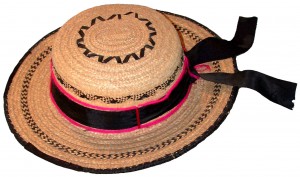The decision to wear traditional clothing or not is often directly related to how much a person interacts with the world outside of his or her own village. For this reason, different styles of clothing can be seen within the same family. For example, Maya men who work as day laborers outside the village may not wear traditional clothing, while their spouses who remain at home continue to do so. This pattern reflects the sexual division of labor found in many Maya communities. Men tend to work outside of the home, either in wage labor or in the household’s cornfields, while women tend to work within the household, either in craft production, childrearing, or housekeeping. Thus, men have adapted to the clothing styles of the world outside of their communities, while women continue to wear what they always have. This pattern is predominant in many Maya villages.

This outfit is typical of the clothing worn by women of Quetzaltenango, Guatemala, a community where some women continue to wear native clothing. The huipil, or blouse, is constructed of three panels of cloth. Where these panels are sewn together, the weaver embroidered multicolored flowers. This design is also continued around the neck. The perraje, or shawl, is woven of cotton and wool and serves multiple purposes. It can be worn around the shoulders on a chilly day in the highlands or folded and carried on top of the head until needed. In some areas, it may be used to cushion a load carried on the head, or it may be used as a carrying cloth to transport an infant or produce from the fields. The corte, or skirt, is made of cotton, and the fabric is typically woven on treadle looms. This skirt is made of two lengths of cloth. The randa, or the area where the two pieces are sewn together, is embroidered with pink, purple, yellow, and burgandy embroidery. The darker area above the randa indicates that this skirt was taken in to accommodate a shorter person and later let out, perhaps as its owner grew taller.

This outfit is worn by the little girls of Totonicapan, a Q’eqchi’ speaking town in Guatemala. It consists of a huipil (blouse), a delantal (apron), a faja (belt, under the apron and not visible), and a corte (skirt). The huipil is made of a single piece of cloth. It is closed at the sides and features a machine-embroidered floral design at the neck. The delantal is worn around the waist and ties at the back. The fabric is of multicolored ikat (tie-dyed) design. This delantal features a ruffle at the hem and lavender embroidery. This pink, dark blue, and white corte is made of cotton and features a double ikat design. A double ikat design is when tie-dyed thread is used as both the warp and the weft of the fabric.
![]()
![]()
![]()
![]()


This outfit is worn by Poqomchi’-speaking women in the Alta Verapaz village of Tucuru, Guatemala. Women of this community are immediately identifiable because of the type of coiledred fabric headdresses that they wear. Supposedly, this headdress is reminiscent of the coral snake. This three-panel huipil is characteristic of Tucuru. It is brocaded and features side panels that contrast with the middle panel. While the brocaded designs may vary by weaver in their placement and exact format, Tucuru huipils usually feature these contrasting panels and are predominantly red in color. The corte that accompanies this huipil is manufactured on a treadle loom and is of a plain balanced weave. This skirt is made of cotton and is gathered at the waist with a drawstring. Below the knee-level of this skirt is a contrasting stripe woven with ikat or tie dyed thread.
Even within a community where men and women both continue to wear traditional styles of clothing, these styles are different and reflect the sexual division of labor. There are only a few villages where men continue to wear traditional clothing, and oftentimes they continue to do so to demonstrate their pride in being Maya. By far, villages where men and women both continue to wear traditional styles of clothing, such as Todos Santos Cuchumatan, San Juan Atitan, and Santiago Atitlan, are exceptions to the rule. Men of these villages are instantly recognizable because of their distinctive clothing styles.


This man’s shirt is from the Mam-speaking community of San Juan Atitan. Colorful embroidery and brocade on homemade fabric make this shirt particularly distinctive. Also, the body of the shirt is made of one piece of fabric, with a V-neck, and is open under the arms rather than down the front like Western-style shirts. Men of this village typically wear loose white pants and straw hats with these shirts.



This shirt, pants, and tzute are typical clothing for a man from San Miguel Chicaj. All three pieces are decorated with brocade.


